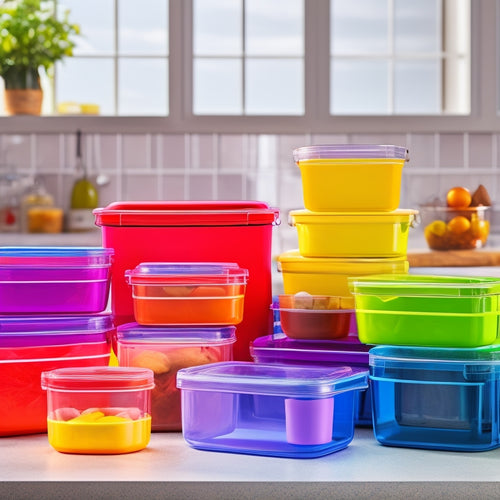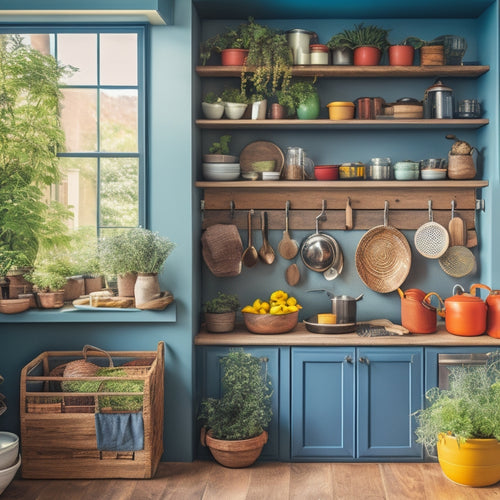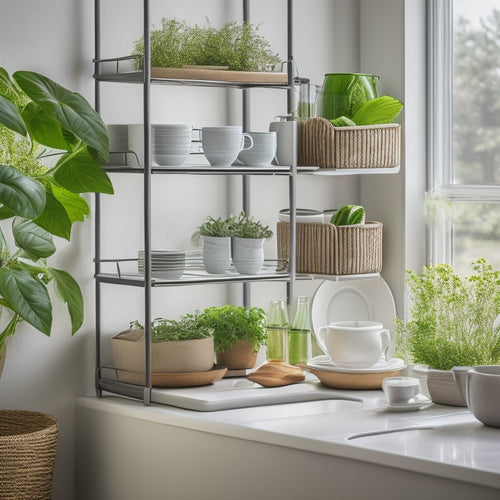
7 Essential Hacks for Tiny Kitchen Storage Success
Share
You're likely no stranger to the frustration of dealing with a tiny kitchen, where every inch of space counts. To maximize your kitchen's potential, start by installing shelves, hooks, or a pegboard on walls to utilize vertical storage. Don't forget to repurpose corners with corner shelves and optimize cabinet organization with drawer dividers and stacking shelves. Wall space can also be utilized with floating shelves, hanging hooks, and magnetic knife strips. Additionally, choose multifunctional furniture, designate a junk drawer zone, and implement a labeling system to keep your kitchen organized. And that's just the beginning - you'll find even more clever storage hacks await you ahead.
Key Takeaways
• Maximize vertical storage space by installing shelves, hooks, or pegboards on walls to optimize kitchen storage.
• Utilize hidden corners effectively with corner shelves, hanging baskets, or lazy Susans to store utensils or snacks.
• Optimize cabinet organization systems with drawer dividers, stacking shelves, and under cabinet hooks to streamline storage.
• Make the most of wall space by installing floating shelves, hanging hooks, or magnetic knife strips to free up counter space.
• Choose multifunctional furniture with built-in storage, such as kitchen carts or tables, to keep essential items within reach.
Maximize Vertical Storage Space
By installing shelves, hooks, or a pegboard on your kitchen's back walls, side walls, or even the back of a cabinet door, you can discover a treasure trove of vertical storage space that previously went unused. This will allow you to store more items without sacrificing precious counter or floor space.
Hanging baskets, for instance, can be used to store fruits, vegetables, or even kitchen utensils, keeping them within easy reach. Stackable shelves can be used to store cookbooks, dinnerware, or infrequently used appliances, freeing up space in your cabinets.
Additionally, consider utilizing the back of a cabinet door or a wall with a magnetic knife holder, over the door hooks, or a pegboard to hang frequently used items like pots, pans, utensils, or even a tea towel. This won't only keep your kitchen organized but also make it look more spacious.
Utilize Hidden Corners Effectively
Now that you've revealed the potential of your kitchen's vertical space, turn your attention to those often-overlooked corners that can be repurposed as valuable storage hubs. These areas are prime real estate for maximizing storage in a tiny kitchen. Corner shelves can be installed to create a convenient spot for frequently used items, such as spices, oils, or cookbooks. You can also utilize hanging baskets to store items like utensils, aprons, or even snacks. Consider installing a lazy Susan in a corner cabinet to make the most of the space and reduce clutter.
When selecting corner storage solutions, consider the items you need to store and choose a system that fits your needs. For example, if you have a lot of small items, opt for a corner shelf with small compartments. If you have larger items, a hanging basket or a corner cabinet with adjustable shelves might be a better fit.
Optimize Cabinet Organization Systems
Take control of your kitchen's chaos by streamlining your cabinet organization systems, and you'll find that everything from finding the right utensils to meal prep becomes a whole lot easier. By optimizing your cabinet space, you'll free up time and energy to focus on what matters most - cooking delicious meals for yourself and others.
Start by implementing drawer dividers to separate utensils, cookware, and dishware. This will prevent clutter from building up and make it easy to find what you need in a flash.
Next, consider installing stacking shelves to maximize vertical storage and keep less frequently used items out of the way.
Don't forget about the often-wasted space under your cabinets. Utilize under cabinet hooks to hang infrequently used items like special occasion dishes or cookbooks. You can also use hanging baskets to store snacks, spices, or oils within easy reach.
Make the Most of Wall Space
You can turbocharge your kitchen's functionality by exploiting the often-overlooked vertical real estate on your walls, where pots, pans, utensils, and even appliances can be cleverly stowed away. By utilizing wall space, you'll free up valuable counter and floor space, creating a more streamlined and efficient cooking environment.
Install floating shelves to store infrequently used items like special occasion dishes or cookbooks. Hanging hooks are perfect for holding pots, pans, and utensils, keeping them within easy reach. For a modern touch, add magnetic knife strips to store your knife collection, keeping them organized and out of the way.
Pot racks are another great option, providing a convenient spot to hang your cookware. Consider a ceiling-mounted pot rack to maximize storage while keeping your walls clear.
Choose Multifunctional Furniture
By selecting multifunctional furniture pieces, such as a kitchen cart with built-in storage or a table with a hidden utensil drawer, you can efficiently optimize your kitchen's square footage. This clever approach allows you to create space saving solutions that cater to your specific needs.
For instance, a kitchen island with a built-in trash can and storage bins can keep your countertops clear while keeping essential items within reach.
When choosing multifunctional furniture, consider your kitchen's unique challenges and prioritize the features that will make the most impact. Do you need extra counter space or additional seating? Perhaps a kitchen table with a built-in storage bench or a wall-mounted foldable table can provide the solution.
Whatever your needs, there's a multifunctional furniture piece that can help you create a more functional and organized kitchen. By incorporating clever storage ideas into your furniture choices, you can create a kitchen that's both beautiful and efficient.
Designate a Junk Drawer Zone
Every kitchen has that one drawer that becomes a catchall for miscellaneous items, so designate a specific drawer as your junk drawer zone to keep clutter at bay. This way, you'll have a dedicated space for storing items that don't have a designated home.
By doing so, you'll be able to maintain a sense of organization in the rest of your kitchen. For instance, you can organize your utensil drawer with dividers and bins to keep frequently used items within easy reach. Meanwhile, utilize under sink storage for items like cleaning supplies and trash bags, freeing up valuable cabinet space.
When designating your junk drawer zone, consider the items you tend to accumulate and categorize them accordingly. You might've a section for batteries, another for twist ties, and another for takeout menus. By grouping similar items together, you'll be able to find what you need quickly and efficiently.
Implement a Labeling System
Once your junk drawer zone is in place, a clear labeling system becomes the key to maintaining order and ensuring that clutter doesn't creep back in. You'll be amazed at how a simple labeling system can transform your tiny kitchen storage.
Start by categorizing your items into groups, such as baking supplies, cooking utensils, and snacks. Then, create color coded labels to match each category. This visual system will help you quickly identify where items belong, making it easier to put things back in their place.
When it comes to labeling tips, remember to keep it concise and descriptive. Avoid using generic labels like 'Misc.' or 'Kitchen Stuff.' Instead, opt for specific labels like 'Spices' or 'Oven Mitts.'
You can also use labels to indicate the contents of containers or bins, making it easy to see what's inside without having to dig through. By implementing a clear and consistent labeling system, you'll be able to maintain your tiny kitchen's organization and keep clutter at bay.
Frequently Asked Questions
How Do I Declutter My Kitchen Without Getting Rid of Essentials?
" Channel your inner Victorian-era organizer and tackle that cluttered kitchen! You'll whip it into shape by incorporating creative shelving, hidden compartments, and clever categorization, ensuring you keep essentials within easy reach, sans the chaos."
Can I DIY My Own Kitchen Storage Solutions on a Budget?
You can create your own kitchen storage solutions on a budget by thinking outside the box! Get creative with shelving using reclaimed wood or pipes, and repurpose upcycled containers to maximize space and style.
What Are the Best Storage Containers for a Tiny Kitchen?
"Measure twice, cut once" - wise words for your tiny kitchen storage quest! You'll love stackable organizers and clear bins that maximize vertical space, keep contents visible, and make meal prep a breeze, all while staying within your budget!
How Often Should I Reorganize My Kitchen Storage Systems?
You should reorganize your kitchen storage systems every 2-3 months, incorporating storage rotation and seasonal updates, to maintain a smooth flow and make sure everything remains easily accessible, making cooking and serving a breeze.
Are There Any Kitchen Storage Hacks for Renters With Limited Customization Options?
Did you know that 37% of renters move every 2 years? You can still optimize your kitchen storage despite limited customization options! Try using temporary shelving units and hanging hooks to maximize space without damaging walls or committing to permanent installations.
Related Posts
-

Stackable Kitchen Containers for Modular Systems
Stackable kitchen containers for modular systems change your cooking space by maximizing vertical storage and enhanci...
-

Over-The-Door Kitchen Rack Installation Tips
To install an over-the-door kitchen rack effectively, start by measuring your door's clearance to guarantee a proper ...
-

Tiered Dish Rack Organizers for Compact Spaces
Tiered dish rack organizers are perfect for compact spaces, maximizing vertical storage while saving precious counter...


